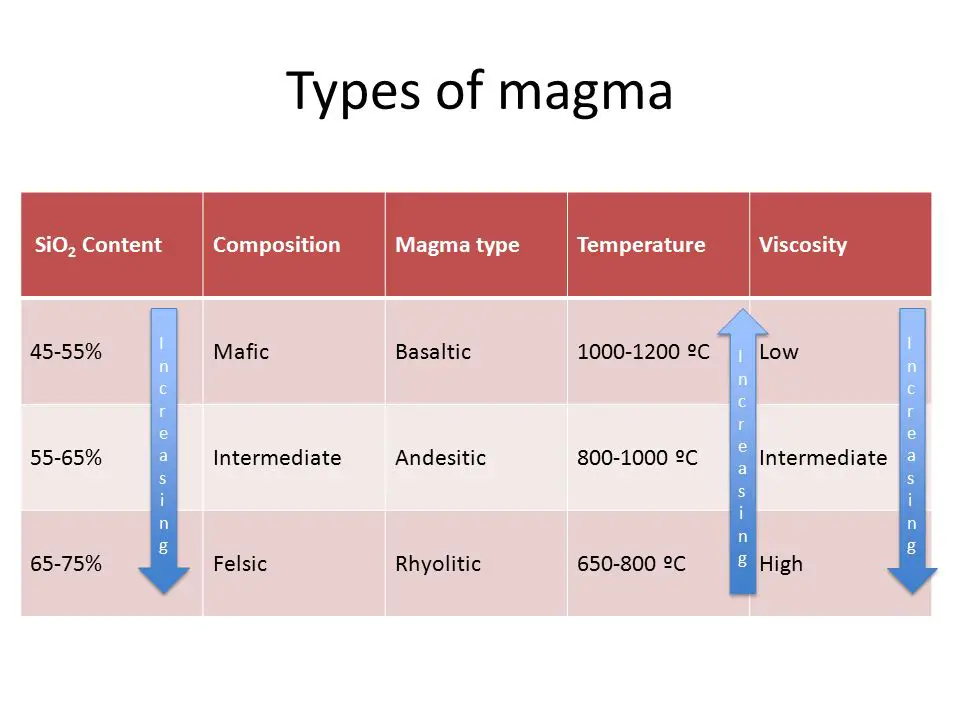Just like there are different types of volcanoes and different types of lava, there are different types of magma. Magma is molten rock within the surface of the earth. There are three basic types of magma: basaltic, andesitic, and rhyolitic, each of which has a different mineral/chemical composition.
- Basaltic magma — SiO2 45-55 wt%, high in Fe, Mg, Ca, low in K, Na
- Andesitic magma — SiO2 55-65 wt%, intermediate. in Fe, Mg, Ca, Na, K
- Rhyolitic magma — SiO2 65-75%, low in Fe, Mg, Ca, high in K, Na

Contents
Basaltic Magma
Basaltic magma’s silica content sits at around 45-55%. This type of magma is abundant amounts of the minerals magnesium, iron, and calcium. But, it is quite low in sodium and potassium.
Of all the magma types, basaltic magma is the most fluid. Though, it is not as fluid as water. Once basaltic magma cools down, it becomes basalt rock. Basaltic magma is also known as mafic lava.
Andesitic Magma
Andesitic magma has a silica content of 55% to 65% with average levels of sodium, potassium, iron, calcium, and magnesium.
This type of magma hardens quickly once it reaches the surface and becomes andesite rock once it cools.
Rhyolitic Magma
Rhyolitic magma is a jelly-like type of magma that is made up of basaltic magma and siliceous materials. It has a silica content of 65-75%. This type of magma is low in iron, magnesium, and calcium while high in potassium and sodium.
If rhyolite magma is gas-rich it can erupt explosively, forming a frothy solidified magma called pumice (a very lightweight, light-colored, vesicular form of rhyolite) along with ash deposits, and/or ignimbrite. In certain situations, extremely porous rhyolite lava flows may develop.
https://flexiblelearning.auckland.ac.nz/rocks_minerals/rocks/rhyolite.html
| Summary Table | |||||
| Magma Type | Solidified Rock | Chemical Composition | Temperature | Viscosity | Gas Content |
| Basaltic | Basalt | 45-55 SiO2 %, high in Fe, Mg, Ca, low in K, Na | 1000 – 1200 oC | Low | Low |
| Andesitic | Andesite | 55-65 SiO2 %, intermediate in Fe, Mg, Ca, Na, K | 800 – 1000 oC | Intermediate | Intermediate |
| Rhyolitic | Rhyolite | 65-75 SiO2 %, low in Fe, Mg, Ca, high in K, Na. | 650 – 800 oC | High | High |
Felsic Magma (Rhyolitic)
If this were a list based on types of magma based on silica content, then felsic magma would sit at the top with 65% and 70%. It is also rich in feldspar and silica.
Because of its high silica content, felsic magma is viscous, i.e. sticky, hence eruptions involving this type of magma tend to be violent. It’s common in hot spots in continental crust (Yellowstone National Park) and in continental rifts.
Mafic Magma (Balsatic)
Mafic magma, on the other hand, has a low viscosity and mafic eruptions tend to be less violent due to the ability of water and other volatiles to escape more easily. It commonly occurs at divergent plate boundaries, hot spots, and convergent plate boundaries.
Intermediate Magma (Andesitic)
Intermediate magma has higher silica content (roughly 60%) than mafic magma but lower than felsic magma. This results in higher gas content and viscosity. And, like felsic magma, it is thick and jelly-like. It usually occurs at convergent plate boundaries and island arcs.
Ultramafic Magma
Komatiite magma or ultramafic magma no longer occurs due to cooler temperatures. However, this type of magma, when turned to lava, was fast flowing and extremely hot (2900ᵒ Fahrenheit).
Further reading:
- Volcanoes, Magma, and Volcanic Eruptions – Tulane University –https://www.tulane.edu/~sanelson/Natural_Disasters/volcan&magma.htm
- Types of magma. Characteristics of magma Composition: types of elements and amount of gases in the magma – Felsic: contains more silica and alumina – https://slideplayer.com/slide/10904450/
What Is Magma? – What are the four parts of magma?
Magma is a molten and semi-molten rock mixture found under the surface of the Earth. This mixture is usually made up of four parts: a hot liquid base called the melt; minerals crystallized by the melt; solid rocks incorporated into the melt from the surrounding confines; and dissolved gases.
What Is The Difference Between Magma And Lava?
Scientists use the term magma for molten rock that is underground and lava for molten rock that breaks through the Earth’s surface.

